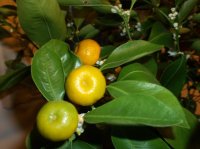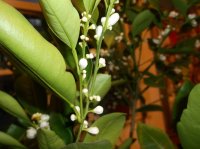Nyboy
Garden Master
- Joined
- Oct 2, 2010
- Messages
- 21,365
- Reaction score
- 16,251
- Points
- 437
I have 3 different citrus trees, a Meyer lemon, Lime and a Calamondin. The Meyers produces the best tasting fruit of the 3,but can be a fussy tree. The Calamondin is so much more forgiving, It flowers and fruits all year, slow growing and does well in containers. It does have to be brought inside during winter. Right now my under 3 foot tree as about a couple hundred flowers. The tree ripen fruit is very sour and small, it is used in a lot of Philippine

 cooking.
cooking.

 cooking.
cooking.